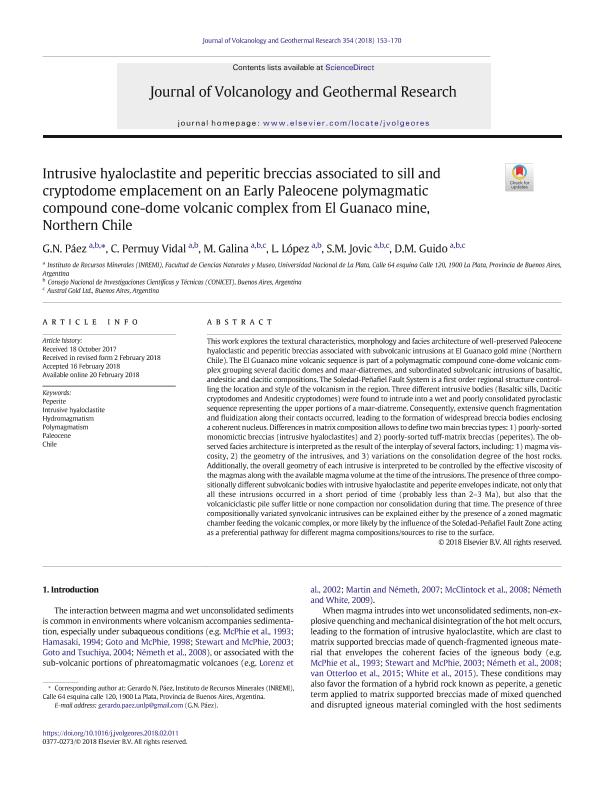Artículo
Intrusive hyaloclastite and peperitic breccias associated to sill and cryptodome emplacement on an Early Paleocene polymagmatic compound cone-dome volcanic complex from El Guanaco mine, Northern Chile
Paez, Gerardo Nestor ; Permuy Vidal, Conrado
; Permuy Vidal, Conrado ; Galina, Matias
; Galina, Matias ; López, Luciano
; López, Luciano ; Jovic, Sebastian Miguel
; Jovic, Sebastian Miguel ; Guido, Diego Martin
; Guido, Diego Martin
 ; Permuy Vidal, Conrado
; Permuy Vidal, Conrado ; Galina, Matias
; Galina, Matias ; López, Luciano
; López, Luciano ; Jovic, Sebastian Miguel
; Jovic, Sebastian Miguel ; Guido, Diego Martin
; Guido, Diego Martin
Fecha de publicación:
04/2018
Editorial:
Elsevier Science
Revista:
Journal of Volcanology and Geothermal Research
ISSN:
0377-0273
Idioma:
Inglés
Tipo de recurso:
Artículo publicado
Clasificación temática:
Resumen
This work explores the textural characteristics, morphology and facies architecture of well-preserved Paleocene hyaloclastic and peperitic breccias associated with subvolcanic intrusions at El Guanaco gold mine (Northern Chile). The El Guanaco mine volcanic sequence is part of a polymagmatic compound cone-dome volcanic complex grouping several dacitic domes and maar-diatremes, and subordinated subvolcanic intrusions of basaltic, andesitic and dacitic compositions. The Soledad-Peñafiel Fault System is a first order regional structure controlling the location and style of the volcanism in the region. Three different intrusive bodies (Basaltic sills, Dacitic cryptodomes and Andesitic cryptodomes) were found to intrude into a wet and poorly consolidated pyroclastic sequence representing the upper portions of a maar-diatreme. Consequently, extensive quench fragmentation and fluidization along their contacts occurred, leading to the formation of widespread breccia bodies enclosing a coherent nucleus. Differences in matrix composition allows to define two main breccias types: 1) poorly-sorted monomictic breccias (intrusive hyaloclastites) and 2) poorly-sorted tuff-matrix breccias (peperites). The observed facies architecture is interpreted as the result of the interplay of several factors, including: 1) magma viscosity, 2) the geometry of the intrusives, and 3) variations on the consolidation degree of the host rocks. Additionally, the overall geometry of each intrusive is interpreted to be controlled by the effective viscosity of the magmas along with the available magma volume at the time of the intrusions. The presence of three compositionally different subvolcanic bodies with intrusive hyaloclastite and peperite envelopes indicate, not only that all these intrusions occurred in a short period of time (probably less than 2–3 Ma), but also that the volcaniciclastic pile suffer little or none compaction nor consolidation during that time. The presence of three compositionally variated synvolcanic intrusives can be explained either by the presence of a zoned magmatic chamber feeding the volcanic complex, or more likely by the influence of the Soledad-Peñafiel Fault Zone acting as a preferential pathway for different magma compositions/sources to rise to the surface.
Palabras clave:
CHILE
,
HYDROMAGMATISM
,
INTRUSIVE HYALOCLASTITE
,
PALEOCENE
,
PEPERITE
,
POLYMAGMATISM
Archivos asociados
Licencia
Identificadores
Colecciones
Articulos(CCT - LA PLATA)
Articulos de CTRO.CIENTIFICO TECNOL.CONICET - LA PLATA
Articulos de CTRO.CIENTIFICO TECNOL.CONICET - LA PLATA
Citación
Paez, Gerardo Nestor; Permuy Vidal, Conrado; Galina, Matias; López, Luciano; Jovic, Sebastian Miguel; et al.; Intrusive hyaloclastite and peperitic breccias associated to sill and cryptodome emplacement on an Early Paleocene polymagmatic compound cone-dome volcanic complex from El Guanaco mine, Northern Chile; Elsevier Science; Journal of Volcanology and Geothermal Research; 354; 4-2018; 153-170
Compartir
Altmétricas



